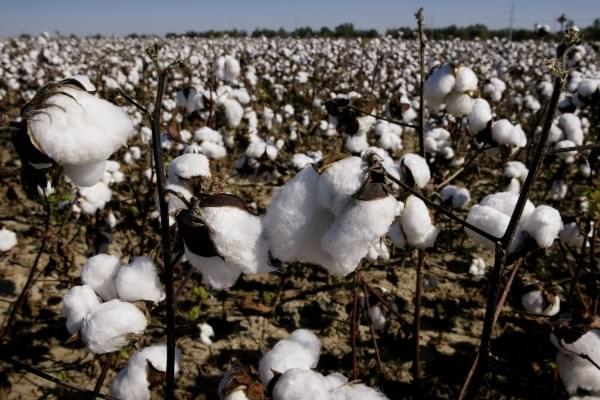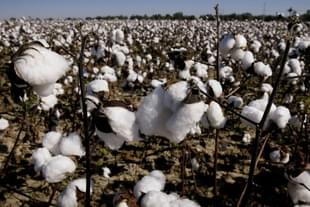Politics
Modi Government Faces Hobson’s Choice Over Farmers’ Demand To Grow Third-Generation Genetically-Modified Cotton
M R Subramani
Jun 19, 2019, 12:35 PM | Updated 12:35 PM IST
Save & read from anywhere!
Bookmark stories for easy access on any device or the Swarajya app.


Lalit Bahale is a cotton farmer hailing from Akoli Jahangir village in Maharashtra. He is also the local leader of the Shetkari Sanghatana (Farmers Union), who cultivates the fibre in 100 acres of his land. He is one of the farmers in the state who has chosen to defy a ban on cultivation of herbicide-tolerant (HT) cotton.
A week ago, Maharashtra Agriculture Department officials conducted a search operation in his house and fields and collected samples of the genetically-modified HT cotton that he is cultivating.
Cultivating the banned HT cotton, besides carrying or storing the variety’s seeds, attracts a fine of Rs one lakh and a five-year imprisonment. The state agriculture department officials have not taken any action against Bahale as a horde of farmers gathered to support Bahale’s move to grow the banned cotton variety.
Akola district collector has sent the samples for testing to the Central Institute of Cotton Research (CICR) and says that reports of the tests are awaited. Maharashtra Agriculture Minister, Sadabhau Khot, on the other hand, has said that the state government will form a team and travel to countries where HT cotton is banned and seek reports from them.
HT cotton is the third generation of genetically-modified cotton in the country that began to be cultivated, starting with the introduction of Bollgard I and subsequently Bollgard II varieties. The HT or the Roundup Ready Flex variety is tolerant to bollworm pests and also the herbicides that are sprayed to kill weeds on cotton farms.
The Bollgard varieties were tolerant only to pests. Most often, farmers are faced with the problems of weed growth on their lands. To get over the problem, they spray herbicides which also affect the cotton or any main plant grown on the farm. The HT variety ensures that herbicides don’t affect the plant as they have been genetically modified so as to tolerate these chemicals.
Various reports say that farmers have been illegally cultivating HT cotton over the last two years. Cotton farmers are looking to replace the older, genetically modified varieties such as Bollgard I and Bollgard II since these are losing their potency. Moreover, pests have reportedly developed resistance to these Bollgard cotton varieties, meaning that the cotton plants are now prone to bollworm attack by these resistant pests.
At least 5.8 million farmers are dependent on cotton, while cotton farming provides indirect employment to another 50 million people. The area under cotton cultivation is second only to rice in the country with the fibre plant accounting for nearly seven per cent of the net sown area. About 60 per cent of the fibre is consumed by the textile industry.
Nearly 65 per cent of the area under cotton is rain-fed and the crop is prone to pests as farmers do not adopt crop rotation as a method for disease control. Cotton is cultivated in 12 million hectares annually and production has averaged around 35 million bales (of 170 kg each) in the last couple of years.
The yield per acre, according to the Cotton Corporation of India, has been over 500 kg per hectare in the last two seasons, though it could drop a tad this season ending September due to drought affecting the crop yield. Cotton yield peaked at 566 kg per hectare during 2013-14.
With yields dropping or plateauing and input costs rising, farmers are looking at various ways to improve productivity and, in turn, their income. It is in this regard that they are looking at HT cotton, which has not been authorised or approved by the Genetic Engineering Appraisal Committee (GEAC). The GEAC is the sole authority to decide on permitting genetically-modified crop cultivation in the country. Currently, only genetically-modified cotton varieties are allowed to be grown in India.
Right now, Maharashtra is witnessing farmers defiance to the ban on HT cotton. Nearly three million farmers in Maharashtra are engaged in cultivating cotton and this is the state where the area under cultivation of the fibre crop is the highest. However, in terms of productivity, Maharashtra ranks last with Gujarat being the leader.
Not surprisingly then that a field survey by CICR has shown that over 40 per cent of the cotton sown in Yavatmal, Wardha, Nagpur and Chandrapur districts are of the banned HT variety. Some farmers in Gujarat, Andhra Pradesh and Telangana too have switched over to the banned variety.
The problem for the centre and the Maharashtra government is how can they stop farmers from cultivating the banned variety. A thorny issue in this is that those who grow HT cotton use the herbicide glyphosate---to which the cotton plant is tolerant---a herbicide that is suspected to be carcinogenic. While the International Agency for Research on Cancer, an arm of the World Health Organisation, says glyphosate probably causes cancer, the European Food Safety Authority holds a contrarian view.
Farmer activist organisation are wondering why growers should be denied technology and it is high time the government explained why growing HT cotton is harmful. The organisations allege that HT cotton is being cultivated in Gujarat without any fear and seeds from there are finding their way to other states.
This takes us back to the situation that the country faced in 2001-02. Then, farmers began growing unauthorised genetically-modified cotton, forcing the government to permit growers to cultivate transgenic cotton varieties rather than risk stopping farmers from growing them.
Last week, farmers owing allegiance to the Shetkari Sanghatana protested against the ban on HT cotton and threatened to cultivate the variety. In fact, this week the Sanghatana has intensified its agitation and asked other farmers, too, to sow HT cotton.
With elections to the Maharashtra Assembly just a couple of months away, the state government cannot incur the growers’ wrath. The issue now is whether HT cotton can be grown or not.
There are, however, two points to remember. One, the United Progressive Alliance (UPA) government had announced an indefinite moratorium on trials of genetically modified crops. Two, US seed firm Monsanto, which has now been bought over by Germany’s Bayer, had in 2015 withdrawn the HT cotton citing “uncertain regulatory environment”.
Probably, the Narendra Modi-led government has dragged its feet for far too long that things are looking to go out of control. First, it has to look at possibilities of allowing, at least, field trials of genetically modified non-food crops. Second, it will have to convince companies like Bayer to bring back HT cotton for trials.
Besides, there are a couple of ways on how the issue can be tackled by the Union and state governments.
One, the centre and state can set up an expert committee to study the whole aspect of HT cotton. Meanwhile, they can ask the farmers to wait for a comprehensive report from the panel that will cover all aspects of HT cotton. Farmers are looking to enhance their income and they need to be given the freedom to cultivate the crop of their choice, as long as they are not harmful and illegal.
The second way is to offer growers an alternative to HT cotton that can provide them with good returns. This will be a tough call since farmers could get agitated if they don’t get the returns as assured and the government may have to incur some financial expenditure.
That leaves the government with Hobson’s choice: allow farmers to grow HT cotton or ban it and risk protests. It would be better for the centre to bite the bullet now than dragging the issue further. It should right away form an expert committee and, at the same time, buy time by convincing the growers to wait for the experts’ report.
M.R. Subramani is Executive Editor, Swarajya. He tweets @mrsubramani





